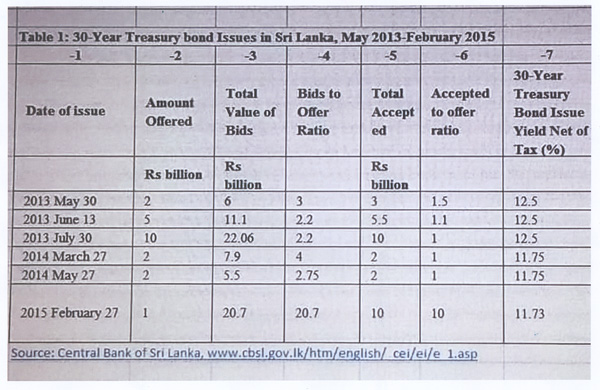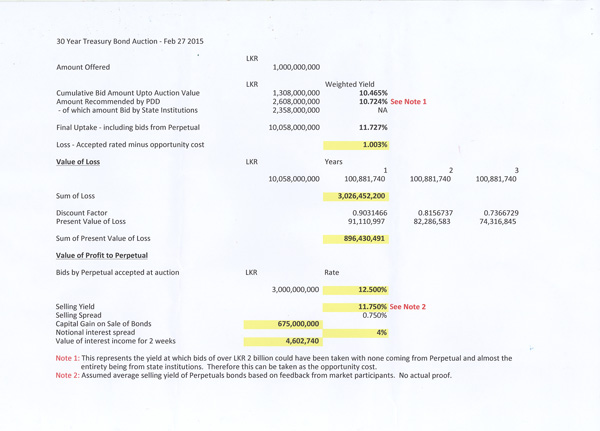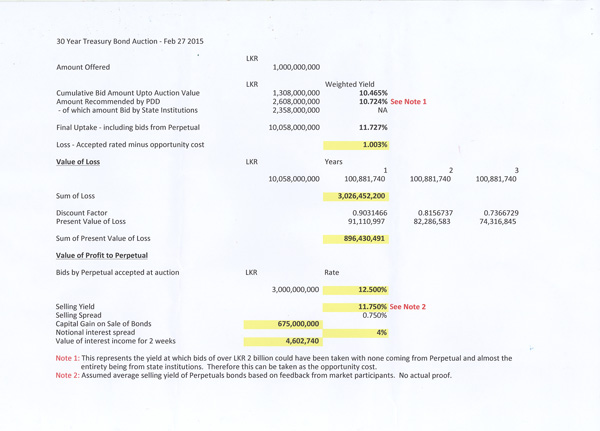Central Bank Bond fiasco – the simple facts (The following is an analysis of the controversial bond issue by a bond specialist)
View(s):The auction
The auction on the 27th February 2015 for 30 year bonds was for Rs. 1 billion. Given the interest rate scenario at the time, the Central Bank (CB) had indicated a range of around 9.5 per cent to 11 per cent p.a. Also in the past the CB has not accepted bids of more than 1.5 times the offered value (see Table 1) in this type of bond historically.
 Based on the above, most genuine bids were in the range indicated by the CB (see Table 2 which is a list of tendered amounts). As primary dealers are required to bid a minimum of Rs. 100 million and given that a 30-year bond is a very risky instrument to be carrying on the balance sheet (given the duration risk and very limited customer base), most primary dealers were putting dummy bids for the minimum quantities at above the indicated range (as per standard practice), where they don’t actually expect their bids to be accepted.
Based on the above, most genuine bids were in the range indicated by the CB (see Table 2 which is a list of tendered amounts). As primary dealers are required to bid a minimum of Rs. 100 million and given that a 30-year bond is a very risky instrument to be carrying on the balance sheet (given the duration risk and very limited customer base), most primary dealers were putting dummy bids for the minimum quantities at above the indicated range (as per standard practice), where they don’t actually expect their bids to be accepted.
The glaring exception was Perpetual Treasuries (the primary dealer linked to the son-in-law of the Governor) that submitted bids of Rs. 5 billion in total, both directly and through the Bank of Ceylon (BOC). Given the risk, it’s very unlikely if not impossible that someone will take such a large exposure to this instrument unless they had some prior information that they would be able get the bids and be able to sell it down subsequently.
The bids up to Rs. 1 billion (as per offered amount) was at a weighted yield of 10.465 per cent p.a. and even at the CB Public Debt Department (PDD) recommended amount of up to Rs. 2.6 billion, the yield was 10.724 per cent p.a. The decision to accept upto Rs. 10 billion (of which main beneficiary of the additional Rs. 7 billion was Perpetual with a Rs. 5 billion facility lined up directly and indirectly through the BOC) resulted in the weighted average yield from the auction increasing to 11.727 per cent p.a. Note that this was the weighted average of the auction, whereas Perpetual actually had their bids accepted up to the cut off of 12.5 per cent p.a.
 Loss to the Issuer
Loss to the Issuer
If we take the difference between the weighted average of the auction and the weighted average up to the POD recommended amount (11.727 per cent – 10.724 per cent p.a.), the loss to the issuer (CB) is about 1.003 per cent p.a., which when applied over 30 years on Rs. 10 billion amounts to Rs. 3 billion which can be discounted to a present value of Rs. 0.9 billion when discounted at 10.724 per cent (see calculation in Table 3). The question is then can this be construed as a loss of revenue to the state carried out willfully by those responsible at the CB, which is deemed an act of corruption under the Bribery Act?
Gain to Perpetual Treasuries
The gain to Perpetual, which can also be considered a loss to other market participants, is harder to calculate and there is no direct proof as above.
The “market talk” is that they sold their bonds at around 11.50 per cent – 11.75 per cent p.a. to insurance companies, etc in the weeks following the auction. This could however be checked by the Commission to Investigate Allegations of Bribery & Corruption. However, hypothetically, assuming Perpetual Treasuries sold only their Rs. 3 billion block at 11.75 per cent p.a. (a gain of 0.75 per cent from the yield of 12.50 per cent at which they got the bonds), that would amount to a capital gain of Rs. 675 million plus net interest income during the period. Obviously, the interest gain component is negligible in comparison to the staggering capital gain that would have been made in a matter of days.
 Correspondingly, the market participants who had bid at much lower levels based on the CB indications incurred a loss when they had their bids accepted at much lower levels than the weighted average of the auction and subsequent secondary market trading levels of this bond. This is what caused outrage within the bond trading circles soon after the issue in question.
Correspondingly, the market participants who had bid at much lower levels based on the CB indications incurred a loss when they had their bids accepted at much lower levels than the weighted average of the auction and subsequent secondary market trading levels of this bond. This is what caused outrage within the bond trading circles soon after the issue in question.
The other concerns are related to market behaviour prior to and after the auction, although there is no direct evidence or means to calculate any profit to Perpetual Treasuries from the same.
Short Selling
The other primary dealers are of the view that Perpetual Treasuries was short selling bonds (which is not strictly allowed but there is no means of monitoring this practice) just prior to the auction. With the shock hike in rates at the auction it is reasonable to expect that Perpetual had been able to close those positions at a substantial profit after the auction. Again there are no means to calculate the gain to Perpetual and loss to others without a detailed audit by experts.
Rate Hike
Prior to the February 27th auction, the CB overnight window had been set at 6.5 per cent – 8 per cent pa. But participants with excess liquidity could only get access to the window 3 times a month and anything more than that was at 5 per cent p.a. So effectively the overnight rate was 5 per cent p.a.
On the same day as the auction, the 3-times-a-month restriction was removed, which effectively amounted to a policy rate from 5 per cent to 6.5 per cent p.a. Therefore the question arises how only Perpetual could have anticipated this resulting in their decision to increase their purchases of the 30 year bond at higher than prevailing/expected rates, and thereby position themselves to gain from this. This is a matter for investigation by the authorities.
Rate Cut
Subsequently in April there was a 0.5 per cent policy rate cut, which again was unexpected and unwarranted given the fiscal situation and the fact that foreign investors were selling out of government bonds with a general expectation of a rate increase. So, some viewed this when taken into context with the above as being beneficial to Perpetual to sell off the bonds they had secured at up to 12.5 per cent interest p.a. – a further bonanza to Perpetual!
Loss Calculations
The various estimates of loss calculations from the disputed auction try to take into account the increase in the yield curve subsequent to the auction and the increase in rates at subsequent auctions. It is not correct to attribute this fact to the disputed auction as rates would have increased based on the fiscal situation and government borrowings, as well as other variables. However, if not for the subsequent policy rate cut in April a more pronounced increase in the yield curve immediately after the February 27th auction would have been visible, although one cannot realistically calculate/attribute subsequent interest rate hikes to the February 27th auction and/or calculate a loss to the government from the same.
Therefore, recent publicity given on the estimated loss to the State from the auction in question being over Rs. 50 billion is simply wrong. The TOTAL interest that will be paid on the bond over its life of 30 years even at 11.72 per cent is Rs. 35 billion (without discounting to the present as normally done to recognize time value of money). The actual loss in fact is the difference between the rate legitimate bidders were bidding at, and the higher rate resulting from the CB’s decision as mentioned above, which amounts to about 1 percentage point on the value of the bond.
 Conclusion
Conclusion
However, what is certain in the final analysis is this: the highly unusual and unprecedented action by the PDD and improbable action taken by ONE primary dealer out of many points towards collusion (insider trading activity) between Perpetual Treasuries, the PDD and the BOC. This collusion resulted in a short term capital gain of no less than Rs. 675 million to Perpetual and a loss to the State of no less than Rs. 900 million.
Conjecture on the extent of the gain or loss as reported in recent media reports is therefore irrelevant and misleading on the basis of this simple calculation using fundamentals of finance. In the final analysis, there is a prima facie ground for an inquiry and possibly indictments by the Bribery Commission that would include officers of the PDD, the BOC and Perpetual.
Insider trading in bond issues has been common practice in Sri Lanka over the last decade or more. Advance knowledge of interest movements have resulted in highly leveraged positions being taken by a handful of primary dealers, yielding capital gains that have produced multi-millionaires and a few billionaires over the years.
The bond trading fraternity knows who they are. Interestingly, no primary dealer who has taken such highly leveraged positions have had to suffer the ignominy of interest moving in the opposite direction, which would have certainly resulted in the bankruptcy of such dealers. None has gone bankrupt. Regrettably unless authorities step in to clean up the rot at the PDD and at corrupt primary dealers, illicit gains will be made. The suspension or revocation of the licence of Perpetual Treasuries and appointment of forensic auditors by the Bribery Commission to frame charges against the “bond trading mafia” would be a good start.
It must also be stated that this bond issue is just the tip of the iceberg in scams in the bond market over the past decade or so triggering the title of ‘Sri Lanka’s bond king” to one powerful individual who once was seen accompanying the former Central Bank Governor on a helicopter trip to the north. Scams in the bond market, far outweigh what has happened in the stock market and needs to be fully investigated.
Highlights
- February 27 bond issue is tip of the iceberg in bond scams that have been going on for more than a decade.
- Given the risk, it’s very unlikely if not impossible that someone will take such a large exposure to this instrument unless they had some prior information that they would be able get the bids and be able to sell it down subsequently.
- Loss to the issuer (CB) is about 1.003 per cent p.a., which when applied over 30 years on Rs. 10 billion amounts to Rs. 3 billion which can be discounted to a present value of Rs. 0.9 billion when discounted at 10.724 per cent
- Loss to the State from the auction is Rs. 35 billion over 30 years
- Collusion between Perpetual Treasuries, the PDD and the BOC resulted in a short term capital gain of no less than Rs. 675 million to Perpetual and a loss to the State of no less than Rs. 900 million.


